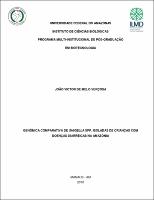| ???jsp.display-item.social.title??? |


|
Please use this identifier to cite or link to this item:
https://tede.ufam.edu.br/handle/tede/7146| ???metadata.dc.type???: | Dissertação |
| Title: | Genômica comparativa de Shigella spp. isoladas de crianças com doenças diarreicas na Amazônia |
| ???metadata.dc.creator???: | Verçosa, João Victor de Melo  |
| ???metadata.dc.contributor.advisor1???: | Nogueira, Patrícia Puccinelli Orlandi |
| First advisor-co: | Alencar, Tainá Raiol |
| ???metadata.dc.contributor.referee1???: | Andrade, Edmar Vaz de |
| ???metadata.dc.contributor.referee2???: | Mota, Adolfo Jose da |
| ???metadata.dc.description.resumo???: | A diarreia é a segunda maior causa de mortalidade infantil no mundo. Dentre as doenças diarreicas, destaca-se a shigelose, uma doença caracterizada pela presença de muco e sangue nas fezes, além de febre, cólica e tenesmos. Atualmente no mundo, ocorrem cerca de 165 milhões de casos da doença com 1,5 milhões de mortes por ano. Essa doença tem como seu agente etiológico a Shigella, sendo quatro espécies pertencentes a este gênero: S. flexneri, S. sonnei, S. boydii e S. dysenteriae; sendo as duas primeiras as mais endêmicas no mundo. A patogenicidade da Shigella é dependente do Sistema de Secreção do Tipo 3 (SST3), localizado no pINV, um plasmídeo de invasão encontrado em todas as espécies do gênero. O SST3 expressa proteínas que driblam o sistema imunológico do hospedeiro, fazendo com que a bactéria consiga se alojar e multiplicar-se dentro das células epiteliais do intestino. Além do SST3, podem ser encontrados na Shigella os Sistemas de Secreção Tipo II (SST2) e VI (SST6), o primeiro em S. boydii e o segundo, mais recentemente descrito, em S. sonnei. Um estudo realizado pelo grupo Diagnóstico e Controle de Doenças Infecciosas na Amazônia (DCDIA) em 2009, foram coletadas amostras de fezes de 1339 crianças, no qual foram encontradas 30 cepas de Shigella. Destas, foram selecionadas 7, que seguiram para o sequenciamento completo de seus genomas no equipamento Illumina HiSeq 2500. Os contigs foram montados utilizando a abordagem de novo, no software Velvet e os scaffolds montados pelo ABACAS. A anotação foi feita pelo pipeline do Prokka. As amostras foram classificadas a partir da comparação de sequencias em vários bancos de dados, como Genbank, utilizando a ferramenta BLAST, RDP e SILVA. Das 7 bactérias, 4 foram classificadas como S. flexneri e 3, como S. boydii, uma espécie raramente encontrada fora da índia. Com uma anotação feita pelo KAAS, foram visualizadas vias metabólicas no KEGG, utilizando o pacote Pathway, no qual foi identificado o SST6 nas 3 representantes da S. boydii. Esse sistema garante uma vantagem adaptativa competitiva para a bactéria, podendo ser a resposta do porquê o número de casos com S. boydii fora da Índia tem crescido. |
| Abstract: | Diarrhea is the second leading cause of child mortality in the world. Diarrheal diseases include shigellosis, a disease characterized by the presence of mucus and blood in the faeces, in addition to fever, colic and tenesms. Currently, around 165 million cases of the disease occur worldwide, with 1.5 million deaths a year. This disease has as its etiologic agent the Shigella, being four species belonging to this genus: S. flexneri, S. sonnei, S. boydii and S. dysenteriae; the first two being the most endemic in the world. The pathogenicity of Shigella is dependent on the Type 3 Secretion System (T3SS), located in pINV, an invasion plasmid found in all species of the genus. T3SS expresses proteins that dribble the host's immune system, causing the bacteria to lodge and multiply within the intestinal epithelial cells. Besides the SST3, Type 2 (T2SS) and 6 (T6SS) Secretion Systems can be found in Shigella, the first in S. boydii and the second, more recently described, in S. sonnei. A study conducted by the group Diagnóstico e Controle de DoençasInfecciosasna Amazônia (DCDIA) in 2009, stool samples were collected from 1339 children, in which 30 strains of Shigella were found. From these, 7 were selected, which followed for the complete sequencing of their genomes in the Illumina HiSeq 2500 equipment. The contigs were assembled using the approach de novo in the Velvet software and the scaffolds assembled by ABACAS. The annotation was made by the Prokka pipeline. The samples were classified from the comparison of sequences in several databases, such as Genbank, using the tool BLAST, RDP and SILVA. Of the 7 bacteria, 4 were classified as S. flexneri and 3, as S. boydii, a species rarely found outside India. With an annotation made by KAAS, metabolic pathways were visualized in the KEGG using the Pathway package, in which the T6SS was identified in the 3 representatives of S. boydii. This system guarantees a competitive adaptive advantage for the bacteria and may be the answer as to why the number of S. boydii cases outside India has increased. |
| Keywords: | Shigella Genômica Bioinformática Shigelose SST3 |
| ???metadata.dc.subject.cnpq???: | CIÊNCIAS BIOLÓGICAS |
| Language: | por |
| ???metadata.dc.publisher.country???: | Brasil |
| Publisher: | Universidade Federal do Amazonas |
| ???metadata.dc.publisher.initials???: | UFAM |
| ???metadata.dc.publisher.department???: | Instituto de Ciências Biológicas |
| ???metadata.dc.publisher.program???: | Programa de Pós-Graduação em Biotecnologia |
| Citation: | VERÇOSA, João Victor de Melo. Genômica comparativa de Shigella spp. isoladas de crianças com doenças diarreicas na Amazônia. 2018. 79 f. Dissertação (Mestrado em Biotecnologia) - Universidade Federal do Amazonas, Manaus, 2018. |
| ???metadata.dc.rights???: | Acesso Aberto |
| ???metadata.dc.rights.uri???: | http://creativecommons.org/licenses/by-nc-nd/4.0/ |
| URI: | https://tede.ufam.edu.br/handle/tede/7146 |
| Issue Date: | 29-Aug-2018 |
| Appears in Collections: | Mestrado em Biotecnologia |
Files in This Item:
| File | Description | Size | Format | |
|---|---|---|---|---|
| Dissertação_JoãoVictorVerçosa_PPGBIOTEC.pdf | 1.93 MB | Adobe PDF |  Download/Open Preview |
This item is licensed under a Creative Commons License





